Wrocław
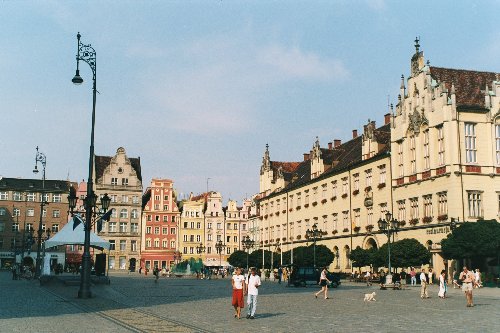
Main square in Wrocław’s old town
Distance
Distances in the area: Kąty Wrocławskie 23 sv, Świebodzice 74 sv, Wałbrzych 76 sv, Ząbkowice Śląskie 67 sv, Nowa Ruda 89 sv, Świdnica 55 sv, Dzierżoniów 62 sv, Jawor 68 sv, Środa Śląska 32 v, Brzeg Dolny 50 nv, Wołów 44 nv, Lubiąż 52 nv, Trzebnica 25 n, Twardogóra 60 no, Oleśnica 31 no, Syców 56 no, Namysłów 63 Island, Jelcz-Laskowice 30 Sun, Oława 27 Sun, Brzeg 42 Sun, Olesno 129 Sun, Strzelin 39 s.
Population
640.000 (2003)
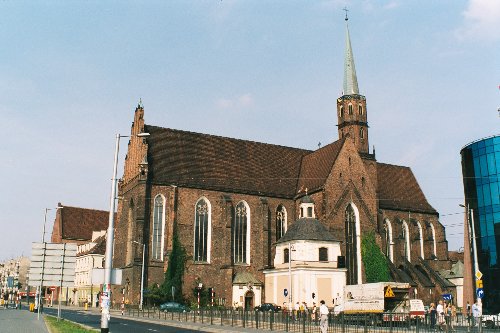
Saint Wojciech’s Church (Kościół św. Wojciecha)
Location and history
Briefly on Wrocław. Location:
Wrocław is an old provincial capital with a historical and cultural significance in line with other major Central European cities such as Gdańsk and Szczecin in Poland or Leipzig, Dresden and Munich in Germany.
Today, Wrocław (the city itself) has approx. 640,000 inhabitants and is thus Poland's fourth largest city (after Warsaw, Łódź and Kraków).
The city has been the capital of the historic Polish province of Lower Silesia since the Middle Ages and today the capital of the county of the same name. Wrocław is located on an old historic trade route connecting the eastern and northern parts of Europe with western and southern Europe.
The town is located on the Wrocław plain, in the center of the Silesian lowlands, on the river Odra, which has several smaller rivers within its territory: Oława, Ślęża, Bystrzyca and Widawa.
In and at Wrocław meet 12 road links and 11 railway lines; moreover, the city has an airport that ensures connection to Warsaw, Frankfurt am Main, Munich and Copenhagen, as well as river ports.
The educational and cultural life is characterized by the university and 12 other colleges, as well as 5 theaters, opera and a philharmonic orchestra.
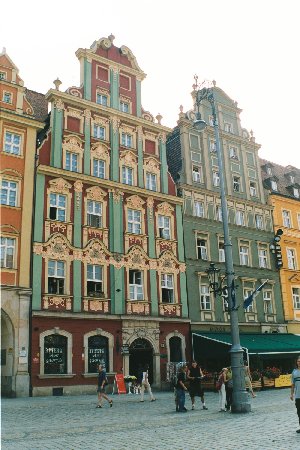
From the main square
History:
Wrocław’s prehistoric existence is documented by numerous excavations with traces of a culture from the 5th century before our time. The oldest part of town is Ostrów Tumski.
In the early Middle Ages, the Slavic tribe Ślężanie had a fortified settlement within the present urban area. In the 10th year. the fortress was occupied by the Czech prince Wracisław, and it is probably his name that has given the city its name.
At the end of the 10th year. Wrocław was incorporated into the Polish state. In the year 1000, King Bolesław Chrobry created a diocesan seat here, which was the seat of the Archdiocese of Gniezno until the year 1821. Wrocław was then an important part of the country's defense system. Witnesses of this include two battles, fought by two different Polish kings: in 1017 Bolesław Chrobry defeated German Emperor Heinrich II at Niemcza, and in 1109 Bolesław Krzywousty fought a victorious battle against Emperor Heinrich V’s forces at the Psie Pole (Dog Field) at Wrocław.
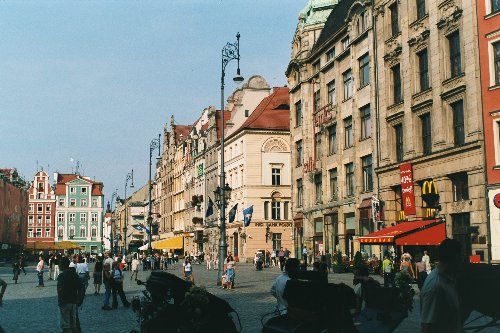
From the main square
During the period of division of the country into principalities, Wrocław became the capital of the Polish Principality and from 1248 in the Principality of Wrocław.
Thanks to the Magdeburg Marketplace, which was granted to the city in 1261, Wrocław embarked on an intensive development, both economically and culturally.
In 1327, the city already numbered 20 thousand inhabitants. By a treaty of 1335, Poland abandoned its claim to Silesia (and including Wrocław), which came under Czech rule. Because of this and due to numerous contacts with trade and cultural superpowers in Europe and Russia, Wrocław became an important commercial center, and the influence of east and west was reflected in the city's architecture and art.
During the Hussitter wars, Wrocław temporarily lost influence. However, a new boom and growth, economic and political, followed later in the 15th century. The city was then one of the strongest trading centers in Europe.
From 1526 the city came under the Habsburgs. Several wars in the 17th and 18th centuries destroyed parts of the city, diminished its political position and hampered its development.
The Prussian and later German rule in Wrocław (now called Breslau) began in 1741, when Austria lost the war with Prussia.
A new boom followed in the 19th century. Population grew rapidly and the area of the city expanded. Wrocław became a major cultural center and the importance of Wrocław University grew.
During World War I and World War II, up to 70% of the city was destroyed or affected by the acts of war. Bombings and fires caused damage or destruction to many medieval building monuments.
From May 6, 1945, Wrocław is again within Poland's borders, and over a long period the city has been carefully rebuilt.
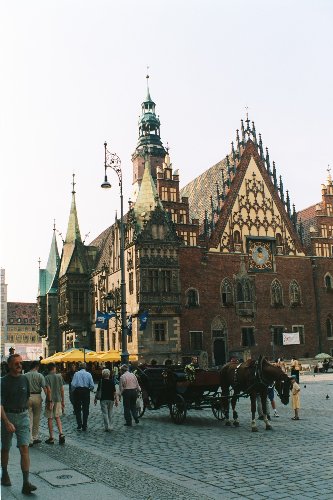
Wrocław Town Hall
Tourist attractions
Square :
The square in the old town is the most beautiful place in the city. Here, as has been the case for centuries, cultural, commercial and tourist life unfold. The square is dominated by the large building of the town hall as well as the related grocery houses.
City Hall :
The late Gothic town hall dates from the 14th to 15th centuries, and has a 66 meter high tower. Its walls are adorned with distinctive bay windows and friezes. Especially the facades to the east and south are admirable. It is one of the most beautiful city hall buildings in Europe. In the building there is
Historical Museum s collections.
Elisabeth's Church slim, 83-meter-high towers rise high above the square's houses; the church is a garrison church and dates from the second half of the 14th century.
Church of Mary Magdelena :
You should also visit the Church of Mary Magdalene on Szewska Street.
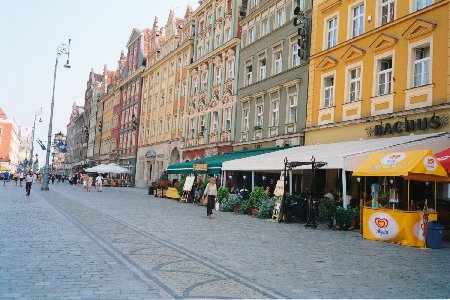
The University :
The university's 171 meter-long building on the Odra River is superbly decorated with works of sculpture and painting, and architecturally it is considered the most valuable buildings of the Baroque period in Poland and Europe. The plan for the construction was ready in 1726 and a few years later construction work began. In the university building you should see the beautiful Aula Leopoldyńska, which is richly decorated with murals. -The obvious
Library Ossolińskich (from 1715) contains many rare letters.
From the old town south of the river, for example. go north and cross Odra via the many bridges, first to the island of Wyspa Piasek and on to the district
Ostrow Tumski (which was also formerly an island, and incidentally is the oldest part of Wrocław); in both places you will find interesting historical buildings, museums and churches. Ostrów Tumski is dominated by:
The cathedral , a Gothic building from the 13th and 14th centuries.
Holy Cross Church (Kościól Św.Krzyża) was founded in 1288 and is considered one of the most valuable buildings of the Gothic period in Silesia.
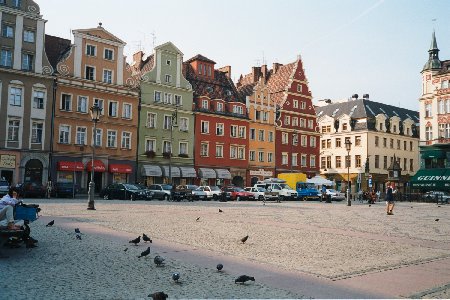
Place Solny in Wrocław’s old town
River Sailings :
There are regular sailing on the river Odra with 5 different ships, of different length and with a duration of 40 min. and up to 8 hours.
The Medieval Violence:
In an area now under the Wrocław-Partynice Racecourse (WTWK Partynice), the audience can follow the reconstruction of the Violence scene from the early Middle Ages.
National Museum (Muzeum Narodowe we Wrocławiu) :
The National Museum, run by the Lower Silesian Municipality, has existed since 1948. Specifically for the museum is the collection of Silesian art from the 12th to the 19th century, Polish art from the 17th to the 19th century. and modern Polish art. The museum also serves as a publisher and publishes catalogs of collections, exhibition catalogs and guides. The museum runs a lively educational business aimed at children, young people and adults alike.
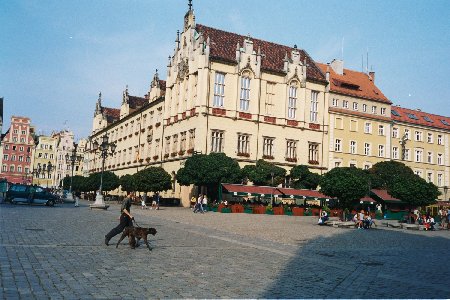
Panorama Racławicka :
is a unique, monumental, panoramic kind of scene painting presented in a special building that is part of the National Museum. The large painting, measuring 15 × 114 meters, was designed with a special technique that makes the viewer set in a different reality and a different time. The painting is the first and only preserved of its kind in Poland. The painting was conceived by Lwów painter Jan Styka (1858-1925), who called for the well-known kind of painter Wojciech Kossak (1857-1942) for cooperation. They were assisted by a number of other artists. The idea of the painting was to commemorate the 100th anniversary of the Battle of Racławice 1794 between a rebel army under General Tadeusz Kościuszko and the Russian army. The painting was unveiled to the public during a country exhibition in Lwów in 1894 and housed in this city in a special roundabout building. After World War II, the Lwów area became Soviet and in 1946 the painting was transferred to Wrocław. Only after a thorough preservation and after the upheavals in 1980 did the artwork become available to the public again in 1985.
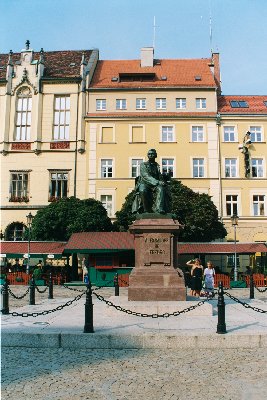
The statue of the Polish author Aleksander Fredro in Wrocław
Zoo (Miejski Ogród Zoologiczny) :
The garden was founded in 1865 but was closed for a period after World War I and during World War II it was destroyed. Since the reopening after World War II, the Zoo has existed continuously. The garden is visited annually by approx. 500,000 people. The zoo covers 33 ha. and has 6,815 animals spread over 559 species, of which 143 are mammals and 160 are bird species.
There are several parks in the city, thus:
Szczytnicki Park , where to find The Japanese Garden (Ogród Japoński) , which is one of the few remaining testimonies of the World Exhibition in Wrocław in 1913. After 1994, the city, in collaboration with the Embassy of Japan in Poland and with the assistance of Japanese specialists, renewed the garden so that it now beautifully represents Japanese garden art again – right down in the smallest details.
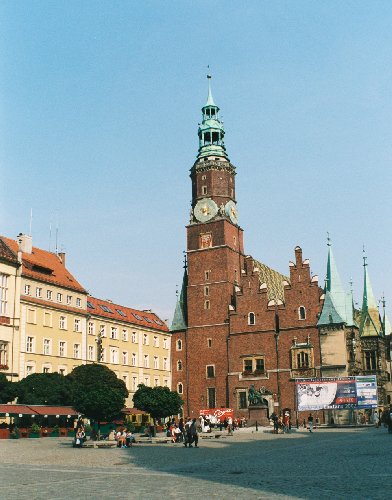
Town Hall Tower
From Wrocław you can go on an excursion to e.g. The Sudeter Mountains or Ślęża Mountain.
h4. Accommodation
Booking.com
VisitWroclaw – in Polish, English, German and Ukrainian – here practical information for tourists
Eating Out:
VisitWroclaw – in Polish, English, German and Ukrainian – here practical information for tourists

Other Internet sites and sources
Wrocław (Official site about Wrocław in Polish, English, German and Ukrainian)
VisitWroclaw – in Polish, English, German and Ukrainian
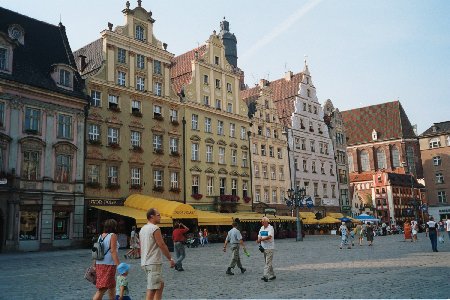
Translated into English by Google Translate. Spangshus.dk accept no liability for any errors or omissions in translation.
Map

Rating
Search
Most used tags
churches (205) Castles (86) Monasteries (79) Town walls (74) Lakes (71) Town halls (67) Rivers (65) Castles1 (62) Mansions (55) Museums (51) Regional museums (38) Town gates (36) Abbey churches (35) Castle ruins (30) Cathedrals (26) Forests (25) Health resorts (24) Water sports (23) Mounds (23) National parks (22)Click for all tags
Denne side er også tilgængelig på dansk. This page and contents is (c) Copyright 2018- www.spangshus.dk. Based on Inviator software by ISCA Software